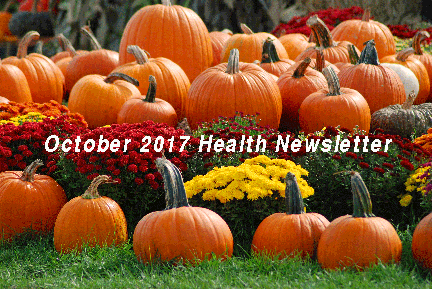
School Readiness Begins with Health! View this email in your browser  October 2017 Health Newsletter
October 2017 Health Newsletter
October is Breast Cancer Awareness Month!
Other than skin cancer, breast cancer is the most common cancer among American women. Getting mammograms regularly can lower the risk of dying from breast cancer. The United States Preventive Services Task Force recommends that if you are 50 to 74 years old, be sure to have a screening mammogram every two years. If you are 40 to 49 years old, talk to your doctor about when to start and how often to get a screening mammogram.
Signs and symptoms of breast cancer
- a change in size or shape of the breast
- a lump or thickening that feels different from the rest of the breast tissue
- redness or a rash on the skin and/or around the nipple
- a change in skin texture such as puckering or dimpling (like orange peel)
- discharge (liquid) that comes from the nipple without squeezing
- your nipple becoming inverted (pulled in) or changing its position or shape
- a swelling in your armpit or around your collarbone
- constant pain in your breast or your armpit
Women should do regular self-examinations and report any breast changes or abnormalities to their provider. If you do not have medical insurance or are worried about the cost of a mammogram there is a program in West Virginia called the West Virginia Breast and Cervical Cancer Screening Program (BCCSP). The program has over 100 screening providers statewide and provides FREE or low cost breast and cervical cancer screenings for qualified West Virginia women.
The contact information for the program is 1-304-558-5388 . More information can be found at: www.wvdhhr.org/bccsp
To learn more about Breast Cancer risk factors, screening and early detection, statistics, and how to lower your risk visit: https://www.cdc.gov/cancer/breast/

NATIONAL DENTAL HYGIENE MONTH
October is National Dental Hygiene Month. For the eighth straight year, the American Dental Hygienists’ Association (ADHA) and Wrigley Oral Healthcare Program (WOHP) have an educational campaign called The Daily 4.THE DAILY 4
The Daily 4 represent the foundation for a healthy smile. Brushing, flossing, rinsing and chewing every day-also using proper technique-won’t guarantee perfect dental hygiene for the rest of your life,but they will improve the color of your teeth, the way your breath smells, the health of your gums, and have a significant impact on your overall health. Are you doing the Daily 4 right?
Brush: Brush for two minutes at least twice each day. Most people like to brush when they wake up and before they go to bed. But brushing after every meal doesn’t hurt! Are you using the correct technique when you brush? Click here to find out.
Floss: Flossing is an important part of your dental hygiene routine. For tips on proper flossing technique, click here.
Rinse: Did you know teeth alone account for less than half of the mouth? Don’t forget about the rest! Rinsing with an antimicrobial mouth rinse helps eliminate biofilm and bacteria that brushing and flossing cannot. Talk with your dentist to figure out which mouth rinse is right for you. For a simple guide on rinsing, click here.
Chew: Believe it or not, chewing sugar-free gum is not just good at curing bad breath. Chewing sugar-free gum also stimulates salivary glands in your mouth, which helps clean out food and neutralize acids found on your teeth. So go ahead, chew some gum after your meal. Just make sure it’s sugar-free!
Learn more at: http://www.adha.org/national-dental-hygiene-month

American Academy of Pediatrics “What’s the Latest With the Flu” Message for Child Care Providers
2017-2018 Influenza Season
It’s time to prepare for the 2017-2018 influenza (flu) season, as the flu is often more serious than the common cold in children. Each year, millions of children get sick with the flu, which can result in hospitalization or death.The 2016-2017 flu season resulted in the hospitalization of thousands of children and the reported deaths of 106 children. One death from influenza is one death too many. In past seasons, between 80% and 85% of flu-related deaths were in children who had not gotten a flu vaccine that season. Take steps now to prevent the flu! Get your influenza vaccination by the end of October, if possible. It’s critically important for everyone to get vaccinated against influenza every year, including children, parents, and child care staff. Influenza immunization is the single best way to reduce flu illness.
For the second season in a row, the American Academy of Pediatrics (AAP) and the Centers for Disease Control and Prevention (CDC) do not recommend that the nasal spray flu vaccine (live attenuated influenza vaccine or LAIV4) be used at all this flu season because of its poor effectiveness the past few years. Therefore, people should only receive a flu shot this season.
Why Vaccination is Important
Annual influenza vaccine is recommended for all people 6 months of age and older. Children younger than 5, but especially children younger than 2 years old, are at an increased risk of hospitalization and complications due to influenza. Since infants younger than 6 months are too young to get their own flu shot, the best way to protect these very young children is for all family members and caregivers to get the flu vaccine. This is called “cocooning”, and it is especially important for adults who care for infants younger than 6 months. Children who have chronic medical conditions, such as asthma, diabetes or neurologic conditions, are also at higher risk for serious complications due to influenza; parents and caregivers can help protect more vulnerable children by vaccinating both the children and themselves.By getting a flu shot during pregnancy, a mother can pass on protection against flu to her newborn baby that will last through the first several months of life. In addition, pregnant women are at high risk of severe illness from influenza, as changes in the immune system, heart, and lungs during pregnancy make pregnant women (and women up to two weeks postpartum) more prone to severe illness and even hospitalization from flu. Flu shots may be given to pregnant women at any time during pregnancy. The vaccine is a safe way to protect the mother and her developing baby from serious illness and complications from flu.
This Season’s Flu Vaccine
The flu vaccine protects against either three virus strains (trivalent) or four virus strains (quadrivalent). Included in the vaccine are the strains that are anticipated to circulate in the US this flu season:- Influenza A (H1N1)
- Influenza A (H3N2)
- Influenza B (2 strains)
The quadrivalent vaccine protects against the same three strains that are in the trivalent vaccine and both influenza B strains. The AAP and the CDC do not have a preference of one vaccine over another this season. The important thing is to make sure everyone gets a flu vaccine!Take Steps TODAY to Help Your Program Prepare- Get your flu vaccine by the end of October, if possible, and encourage all staff, children, and parents to get the flu vaccine. Everyone needs a flu vaccine each year!
- Examine and revise your program’s written plan for seasonal flu.
- Invite a pediatrician or child care health consultant to provide influenza prevention education to your staff.
- Use CDC posters and handouts to educate caregivers and staff about proper hand hygiene and cough/sneeze etiquette.
- Update family contact information and child records, so parents can be reached quickly if they need to pick up their sick child.
Plan Ahead to Prevent the Spread of Germs
Once flu season starts, it can be challenging to keep germs from spreading. While you can catch the flu any time of the year, in the United States the virus is most common in the fall and winter usually peaking between in January, February, and March. But don’t forget that flu activity may start as early as November and as late as May.It can be difficult to tell the difference between flu and the common cold based on symptoms alone. The flu is often worse than the common cold. Some people, however, can be infected with the flu virus and have no symptoms, but still spread the virus to others.Policies in your child care center can limit the spread of the influenza and should focus on encouraging vaccination and implementation of everyday preventive actions like goodrespiratory etiquette, hand washing; cleaning, sanitizing, and disinfecting; and excluding children and caregivers who have respiratory symptoms (cough, runny nose, or sore throat) and fever. The child can return to the center when the fever has resolved (without the use of fever-reducing medicine), the child is able to participate in normal activities, and staff can care for the child without compromising their ability to care for the other children in the group.Resources
- AAP Caring for Our Children National Health and Safety Performance Standards
- AAP Flu: A Guide for Parents of Children or Adolescents with Chronic Health Conditions
- AAP is it Safe for a Baby to Get the Flu Vaccine in March and April, and then Get the Next Season’s Flu Vaccine in August?
- AAP Managing Infectious Diseases in Child Care and Schools: A Quick Reference Guide
- AAP Preparing Child Care Programs for Pandemic and Seasonal Influenza
- AAP Preventing the Flu: Resources for Parents and Child Care Providers
- AAP Why should my Son Get the Flu Shot at the Pediatrician’s Office vs. a Retail-based Pharmacy?
- CDC Fact Sheet No More Excuses: You Need a Flu Vaccine!
- CDC Flu Information – Free Print Materials
- Families Fighting Flu Web Site
- Prevent Childhood Influenza Web Site
This message is also available on this page: https://www.healthychildren.org/English/news/Pages/Whats-the-Latest-with-the-Flu-A-Message-for-Caregivers-and-Teachers.aspx.
Every day, you make decisions about your health. Health doesn’t just happen at the hospital or your doctor’s office. You make health decisions at home, at work, where you shop, and where your children play. You make health decisions not only when you are sick, but also in how you prevent sickness and injuries in your family. Good information is the key to taking care of your health and the health of your family.
Most Adults have a hard time understanding the information that they find in health clinics, hospitals, stores, newspapers, and online. When people do not understand health information, they are more likely to:
- Skip appointments that can keep them healthy
- End up in the emergency room
- Have trouble caring for health problems such as diabetes or high blood pressure
- Miss important prevention tips
Source: https://eclkc.ohs.acf.hhs.gov/
Thank You for viewing this month’s Health Newsletter. Please send any questions, comments, or suggestions to tiffanypigott@ncwvcaa.org or the below contact information.



